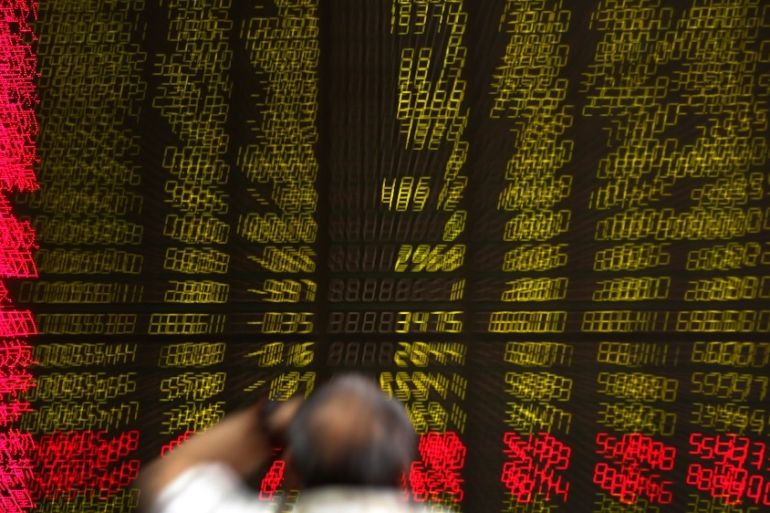Stocks get a boost from US jobs data, oil rises after OPEC+ deal
US non-farm payrolls unexpectedly increased in May, and the world’s top oil producers agreed to extend output cuts.

Asian shares and United States stock futures advanced on Monday after a surprise recovery in US employment gave further confidence of a quick economic rebound after many weeks of lockdowns aimed at controlling the coronavirus pandemic.
Meanwhile, oil prices rose after the Organization of Petroleum Exporting Countries, Russia and allies, collectively referred to as OPEC+, agreed on Saturday to extend record oil production cuts until the end of July.
Keep reading
list of 3 itemsOPEC+ extends output cuts through July and cracks down on cheats
‘The good times continue to roll’: Stocks jump on recovery hopes
US S&P500 stock futures rose 0.5 percent to stand near their highest levels since late February while Japan’s Nikkei opened more than 1 percent higher.
MSCI’s broadest index of Asia-Pacific shares outside Japan rose 0.3 percent in early trade, with South Korea’s Kospi rising 1.4 percent. The Australian share market was closed for a holiday.
US nonfarm payrolls rose by 2.509 million jobs last month – in contrast with consensus estimates of a fall of eight million jobs after a record plunge of 20.687 million in April.
The Labor Department’s closely watched employment report also showed the jobless rate falling to 13.3 percent last month from 14.7 percent in April, a post-World War II high. Economists had forecast the rate jumping to 19.8 percent.
“Although there are some risk factors such as weekend demonstrations in the United States and concerns about the second wave of the coronavirus, hopes of economic reopening are taking the lead,” said Masahiro Ichikawa, senior strategist at Sumitomo Mitsui DS Asset Management.
US bond prices have tumbled, with the 10-year Treasuries yield rising to as high as 0.959 percent on Friday, a level last seen in mid-March. Bond prices and yields move in opposite directions.
The sharp gains in US bond yields over the last few of days put more focus on the US central bank, which will hold a two-day policy meeting ending on Wednesday.
Federal Reserve chairman Jerome Powell has said the US economy could feel the weight of the economic shutdown for more than a year.
Chinese trade data published on Sunday also showed the continuing impact of the epidemic.
Exports contracted in May as global coronavirus lockdowns continued to devastate demand, while a sharper-than-expected fall in imports pointed to mounting pressure on manufacturers as global growth stalls.
Energy boost
In the energy markets, Brent crude oil rose more than 2 percent to $43.32 a barrel while US crude futures gained 2 percent to $40.36 after deal among the OPEC+ countries to extend their agreement to reduce production.
OPEC+ had initially agreed in April that it would cut supply by 9.7 million barrels per day (bpd) during the May-June period to prop up prices that collapsed due to the coronavirus crisis. Those cuts were due to taper to 7.7 million bpd from July to December, but will now be maintained at the original level until the end of July.
But some analysts cautioned that ensuring all members of the cartel carry out their promised cuts will be hard, despite an agreement by countries such as Nigeria and Iraq, which have been producing more than they should have, to make deeper reductions in output.
“Given that there is no enforcement mechanism, it is difficult to believe that the likes of Iraq will suddenly start to comply with the deal,” Dutch bank ING’s commodities strategists Warren Patterson and Wenyu Yao wrote in a research note sent to Al Jazeera.
“The deal does not change our medium/long term view of the market, and we expect ICE Brent to still average $50 [a barrel] over the final quarter of this year.
Oil prices have doubled since April as OPEC+ cuts trimmed a global glut and demand staged a rebound after the easing of restrictions in some countries, particularly China. Still, a sustained recovery may be hampered by deteriorating relations between Washington and Beijing, a second wave of infections, or returning US shale supply following a gain in crude prices.
Gold prices slipped to $1,681.0 an ounce (about $52.22 a gramme), near its lowest levels since late April.
In the currency market, safe-haven currencies were softer while risk-sensitive ones outperformed.
The Japanese yen stood at 109.67 to the dollar, near Friday’s 10-week low of 109.85.
The euro changed hands at $1.1303, not far off three-month high of $1.1384 touched on Friday while the Australian dollar stood at $0.6993, near its highest this year.
The offshore Chinese yuan hit its highest level in five weeks at 7.0669 to the dollar.